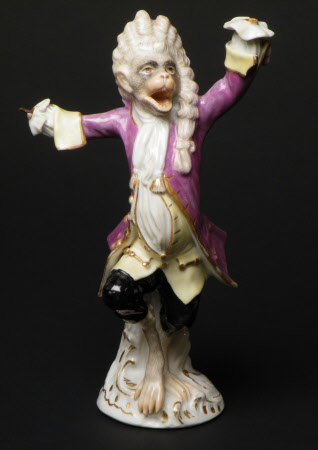This blog continues in the “Europe & the U.S. in 99 Objects” series. Dr. Gabriella de la Rosa at the National Trust has started this project for the National Trust, originally published here, by delving into the Trust’s collections – nearly 1 million objects held at over 200 historic properties across the United Kingdom – to find objects with interesting, unusual and unexpected connections to Europe. These objects and their stories are being published in the form of a digital diary on the National Trust Collections website.
#4 Monkey
Bewigged monkeys cavorting in courtly attire may be kitsch by today’s standards, but they were all the rage with 18th-century French aristocrats. ‘Singerie’ – the French word for the depiction of monkeys in anthropomorphic scenes – peaked in the work of the Christophe Huet. His decorations for the Château de Chantilly of monkeys hunting, sledging and tight-rope walking are a supreme achievement of this whimsical Rococo genre. Inspired by Huet’s work, Johann Joachim Kändler – the most celebrated modeller at Germany’s Meissen porcelain factory – designed a full orchestra of simian musicians and this ceramic figure is one of them. The monkey orchestra became one of Meissen’s most celebrated designs. Despite being a supporter of and shareholder in the Sèvres Porcelain Manufactory, Madame de Pompadour, the cultivated mistress of Louis XV, purchased a 19-piece Meissen monkey orchestra in 1753. Like many others she was clearly captivated by these fashionable figurines.
Category: Ceramics
Date: 1755
Materials: ceramic
Place of origin: Meissen
Collection: Polesden Lacey, Surrey (Accredited Museum)
Not on show NT 1245667
#5 Caroline-Marie Bonaparte, Caroline Murat, Queen of Naples (1782-1839)

Caroline-Marie Bonaparte, Caroline Murat, Queen of Naples (1782-1839) by Louis Ducis (Versailles 1775 ¿ Paris 1847)
Celebrity culture is nothing new. The naked ambition of the parvenu Bonapartes could give the Kardashians a run for their money. Caroline-Marie Bonaparte, Napoleon’s younger sister, was nothing if not image-conscious. She was also status-obsessed and politically ambitious. Talleyrand, Napoleon’s chief diplomat, once described her as having ‘the head of Cromwell on the shoulders of a pretty woman.’ In her marriage to Joachim Murat, Napoleon’s brazen and daring cavalry officer, Caroline met her match. Together they vied for positions of political influence whilst enjoying a lavish lifestyle of ostentation and luxury. Their thirst for power was momentarily appeased when in 1808 they were appointed King and Queen of Naples. Joachim, who was notoriously vain and always flamboyantly dressed, became known as the ‘the Dandy King’. But the Murats’ constant political manoeuvring backfired with the defeat of Napoleon in 1815. Arrested by Ferdinand I, the newly restored King of Naples, Joachim was court-martialled and sentenced to death. He is purported to have issued the command to execute by shouting, ‘Soldiers! Follow your duty! Straight to the heart but spare the face… Fire!’ During her brief reign as queen, Caroline used portraiture to construct various identities for herself, including that of patron, ruler, mother and style icon. In this example by Louis Ducis, Caroline wears a dress that is a distinctive hybrid of French and Italian fashions, marrying the Neapolitan tradition of black velvet to the Empire-waist silhouette made popular by her sister-in-law and fellow fashionista, Josephine Bonaparte. After the demise of her first husband, Caroline remarried and settled in the Italian port of Trieste, styling herself the Countess of Lipona – an anagram of Napoli – asserting and refashioning her identity until the end.
Category: Art / Oil paintings
Date: circa 1810
Materials: Oil on canvas
Measurements: 825 x 635 mm (32 1/2 x 25 in)
Place of origin: Naples
Collection: Attingham Park, Shropshire (Accredited Museum)
On show at: Attingham Park, Shropshire, Midlands, National Trust
NT 608957





